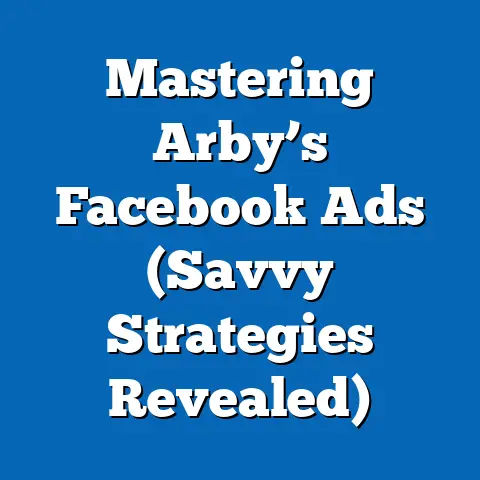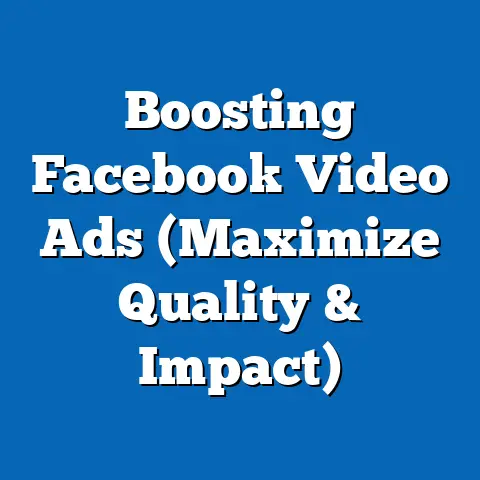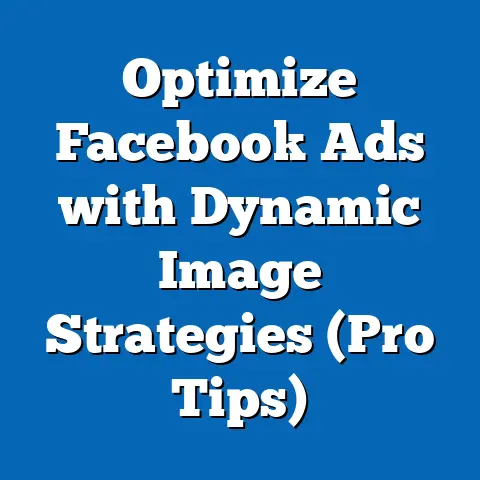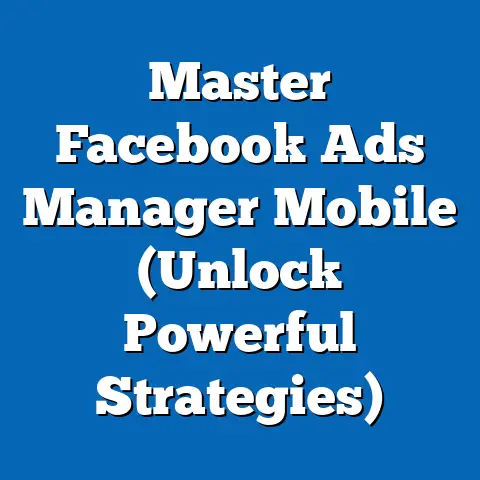Maximize ROI with Day Parting Facebook Ads (Strategic Insights)
I’ve seen firsthand how much of a difference strategic timing can make in Facebook advertising. It’s not just about having a great ad; it’s about showing it to the right people at the right time. And that’s where day parting comes in. Did you know businesses see a potential 30% increase in ROI when they utilize strategic day parting in their Facebook ad campaigns? It’s a game-changer, and I’m going to walk you through everything you need to know to make it work for your business.
Understanding Day Parting
Day parting, in the context of advertising, is the practice of scheduling your ads to run only during specific times of the day or days of the week. Think of it like this: you wouldn’t open your physical store at 3 AM, right? The same logic applies online. Day parting allows you to target your audience when they are most likely to be active and receptive to your message.
In digital marketing, this strategy is critical because it maximizes your ad spend by ensuring your ads are seen by the right people at the right time. Instead of running your ads 24/7 and potentially wasting impressions on inactive users, you can focus your budget on the hours when your target audience is most engaged.
The effectiveness of day parting is rooted in the psychological and behavioral patterns of consumers. People behave differently at different times of the day. For example:
- Morning: People often check social media for news and updates as they start their day.
- Lunch Break: Many users scroll through Facebook for entertainment or to catch up with friends.
- Evening: After work, people tend to relax and browse social media for leisure.
Understanding these patterns allows you to tailor your ad messaging and timing to match the user’s mindset, significantly improving ad performance.
Takeaway: Day parting is a strategic scheduling technique that optimizes ad spend by targeting users during peak engagement times, aligning with their daily routines and psychological states.
The Importance of ROI in Facebook Advertising
ROI, or Return on Investment, is the holy grail of any marketing campaign. In Facebook advertising, ROI measures the profitability of your ad spend. It tells you how much money you’re earning for every dollar you invest in your ads. Calculating ROI helps you determine whether your campaigns are successful and worth continuing.
The basic formula for calculating ROI is:
ROI = (Net Profit / Cost of Investment) * 100
In Facebook advertising, net profit is the revenue generated from your ads minus the cost of running those ads. For example, if you spend $1,000 on ads and generate $3,000 in revenue, your ROI would be:
ROI = (($3,000 - $1,000) / $1,000) * 100 = 200%
This means you’re earning $2 for every $1 spent, which is a fantastic return.
Several factors can affect your ROI in Facebook advertising campaigns:
- Ad Spend: How much you invest in your ads directly impacts your potential reach and conversions.
- Audience Targeting: Reaching the right audience with relevant ads is crucial for driving engagement and conversions.
- Ad Creative: Compelling visuals and persuasive copy can significantly improve click-through rates and conversion rates.
- Landing Page Optimization: A seamless and user-friendly landing page is essential for converting ad clicks into sales.
- Bidding Strategy: Choosing the right bidding strategy can help you optimize your ad spend and maximize ROI.
I remember working with a local bakery that was struggling to see a return on their Facebook ads. They were running ads 24/7 with a generic message. After implementing a focused strategy that targeted local residents during breakfast and lunch hours with mouthwatering images of their pastries, their ROI increased by 150% within a month. This shows how crucial it is to align your ads with the right audience and the right time.
Takeaway: ROI is a critical metric for evaluating the success of Facebook ad campaigns. Optimizing factors such as ad spend, audience targeting, and ad creative can significantly improve your return on investment.
Analyzing Audience Behavior
To effectively implement day parting, you need to understand when your target audience is most active on Facebook. Fortunately, Facebook provides several tools and methods to analyze audience behavior.
Facebook Insights: This is your primary resource for understanding your audience. Facebook Insights provides detailed data on your followers, including:
- Demographics: Age, gender, location, education, and job titles.
- Interests: Hobbies, pages they like, and topics they engage with.
- Behavior: Purchase behavior, device usage, and online activity.
- Engagement: When your audience is most active on Facebook.
To access Facebook Insights, go to your Facebook Business Page, click on “Insights” in the left-hand menu, and explore the various tabs to gather valuable data about your audience.
Audience Insights: This tool helps you learn about people on Facebook, so you can create more relevant ad campaigns. With Audience Insights, you can:
- Discover Potential Audiences: Identify new audience segments based on demographics, interests, and behaviors.
- Understand Existing Audiences: Gain deeper insights into your current followers.
- Compare Audiences: See how different audience segments compare in terms of demographics, interests, and behaviors.
Third-Party Analytics Platforms: Several third-party analytics platforms can provide additional insights into your audience behavior on Facebook. These tools often offer advanced analytics and reporting features that can help you fine-tune your day parting strategy.
For example, let’s consider a retail business targeting young adults. Facebook Insights might reveal that their target audience is most active on Facebook during the evening hours (7 PM to 10 PM) and on weekends. This information can be used to schedule ads specifically during these peak times, maximizing the chances of reaching and engaging with potential customers.
Different industries can also benefit from understanding their audience’s online behavior patterns:
- Hospitality: Restaurants and bars can target ads during lunch and dinner hours to attract customers looking for a place to eat or drink.
- E-Commerce: Online stores can focus their ad spend on weekends when people have more time to browse and make purchases.
- Education: Schools and universities can target ads during weekdays when students are likely to be online and researching educational opportunities.
Takeaway: Analyzing audience behavior using Facebook Insights, Audience Insights, and third-party analytics platforms is crucial for identifying peak engagement times and optimizing day parting strategies.
Implementing Day Parting Strategies
Now that you understand the importance of day parting and how to analyze audience behavior, let’s dive into how to implement day parting strategies in your Facebook ad campaigns.
Step 1: Define Your Objectives: Before you start scheduling your ads, clearly define what you want to achieve with your campaign. Are you looking to drive traffic to your website, generate leads, or increase sales? Your objectives will influence your targeting and messaging.
Step 2: Analyze Audience Behavior: Use Facebook Insights and Audience Insights to gather data on your target audience’s behavior. Identify the days of the week and times of the day when they are most active on Facebook.
Step 3: Create Your Ad Campaign: Set up your ad campaign in Facebook Ads Manager, choosing the appropriate campaign objective, audience targeting, and budget.
Step 4: Schedule Your Ads: In the “Ad Scheduling” section of your ad set settings, select “Run ads on a schedule.” This option allows you to specify the days and times when your ads will be shown.
Step 5: Select Time Slots: Based on your audience insights, select the time slots when your target audience is most active on Facebook. You can choose multiple time slots and days of the week to create a customized schedule.
Step 6: Monitor and Adjust: After launching your campaign, closely monitor its performance. Track metrics such as impressions, click-through rates, conversion rates, and ROI. If you’re not seeing the results you want, adjust your schedule and ad creatives accordingly.
For example, let’s say you’re running a campaign for a local coffee shop. After analyzing your audience data, you discover that your target audience is most active on Facebook between 7 AM and 9 AM on weekdays and between 10 AM and 12 PM on weekends. You can schedule your ads to run during these peak times, targeting users who are likely to be looking for a morning coffee or a weekend brunch spot.
Case Study:
A fitness studio in New York City implemented day parting to promote their evening yoga classes. They scheduled their ads to run between 5 PM and 7 PM on weekdays, targeting people who had just finished work and were looking for a way to unwind. As a result, they saw a 40% increase in class sign-ups and a significant improvement in their ROI.
Takeaway: Implementing day parting involves defining objectives, analyzing audience behavior, scheduling ads during peak times, and continuously monitoring and adjusting your strategy based on performance data.
Measuring Success and Adjusting Strategies
Once you’ve implemented your day parting strategy, it’s crucial to track its success and make adjustments as needed. Here are some key metrics to monitor:
- Impressions: The number of times your ads are shown to your target audience.
- Click-Through Rate (CTR): The percentage of people who click on your ads after seeing them.
- Conversion Rate: The percentage of people who take a desired action (e.g., make a purchase, sign up for a newsletter) after clicking on your ads.
- Cost Per Acquisition (CPA): The cost of acquiring a new customer or lead through your ads.
- Return on Ad Spend (ROAS): The revenue generated for every dollar spent on your ads.
- Overall ROI: The profitability of your ad spend, taking into account all costs and revenues.
To track these metrics, use Facebook Ads Manager’s reporting tools. You can create customized reports to monitor the performance of your day parting campaigns and identify areas for improvement.
A/B testing is another essential strategy for refining your day parting campaigns. A/B testing involves creating two versions of your ad (A and B) with slight variations in timing, messaging, or ad creative. You then run both versions simultaneously and track which one performs better.
For example, you can test different time slots to see which ones generate the highest engagement and conversion rates. You can also test different ad creatives to see which ones resonate most with your target audience during specific times of the day.
Remember, ongoing analysis and adjustments are key to maximizing the effectiveness of your day parting strategy. The Facebook advertising landscape is constantly evolving, so it’s essential to stay informed about new trends and best practices.
Takeaway: Measuring success through key metrics and A/B testing is essential for refining day parting strategies and maximizing ROI. Continuous analysis and adjustments are necessary to stay ahead in the dynamic Facebook advertising landscape.
Potential Challenges and Solutions
While day parting can be a highly effective strategy, it’s not without its challenges. Here are some common issues that advertisers face when implementing day parting strategies, along with potential solutions:
- Fluctuating Audience Engagement: Audience behavior can change over time due to various factors, such as seasonal trends, holidays, and current events. To address this, regularly monitor your audience data and adjust your schedule accordingly.
- Competition During Peak Times: During peak engagement times, competition for ad placements can increase, driving up ad costs. To mitigate this, consider experimenting with different bidding strategies and ad creatives to stand out from the crowd.
- Inaccurate Audience Insights: Sometimes, Facebook Insights may not provide a complete or accurate picture of your audience’s behavior. To supplement this, consider using third-party analytics platforms and conducting surveys or polls to gather additional data.
- Limited Budget: If you have a limited budget, it can be challenging to run ads during multiple time slots and days of the week. To make the most of your budget, prioritize the time slots that have the highest potential for engagement and conversions.
- Ad Fatigue: If you’re running the same ads for an extended period, your audience may become desensitized to them, leading to a decline in performance. To combat ad fatigue, regularly refresh your ad creatives and messaging.
I once worked with an e-commerce client that was struggling to see results from their day parting campaign. After digging deeper into their audience data, we discovered that their target audience was most active on Facebook during the early morning hours, which was unexpected. We adjusted their schedule accordingly, and their ROI immediately improved. This shows the importance of staying flexible and adapting to changing audience behavior.
Takeaway: Addressing challenges such as fluctuating audience engagement, competition, and limited budgets requires continuous monitoring, experimentation, and adaptation of your day parting strategies.
Conclusion
Day parting is a powerful strategy for maximizing ROI on Facebook ads. By understanding your audience’s behavior and scheduling your ads to run during peak engagement times, you can significantly improve your ad performance and achieve better results.
Remember these key takeaways:
- Day parting is a strategic scheduling technique that optimizes ad spend.
- ROI is a critical metric for evaluating the success of Facebook ad campaigns.
- Analyzing audience behavior is crucial for identifying peak engagement times.
- Implementing day parting involves defining objectives, scheduling ads, and monitoring performance.
- Measuring success and A/B testing are essential for refining your strategy.
- Addressing challenges requires continuous monitoring and adaptation.
I encourage you to take the insights shared in this article and apply them to your own Facebook advertising strategies. By implementing day parting effectively, you can unlock new levels of success and achieve your marketing goals. Don’t just set it and forget it – keep learning, testing, and adapting to the ever-changing landscape of Facebook advertising. Your ROI will thank you for it.





